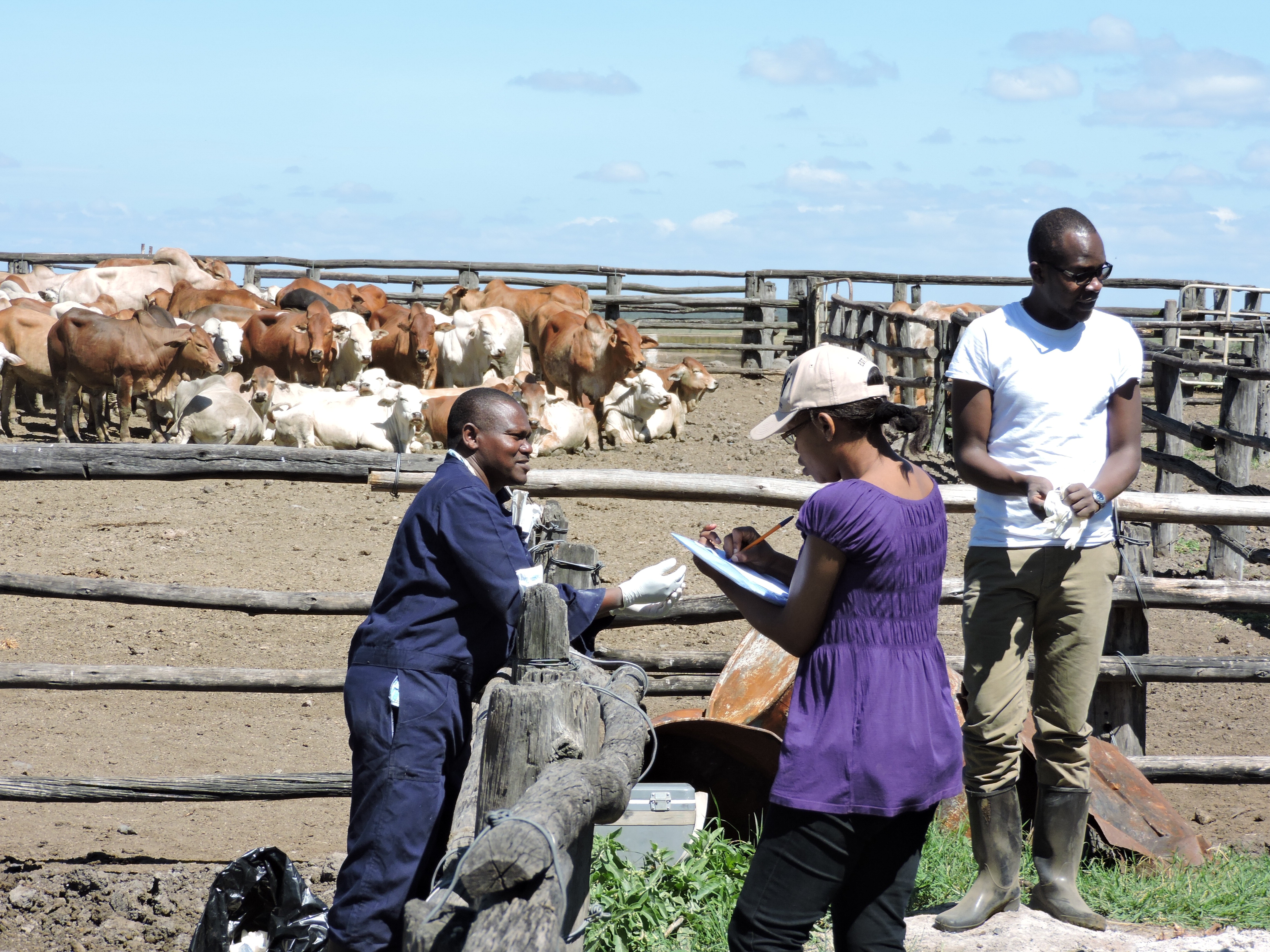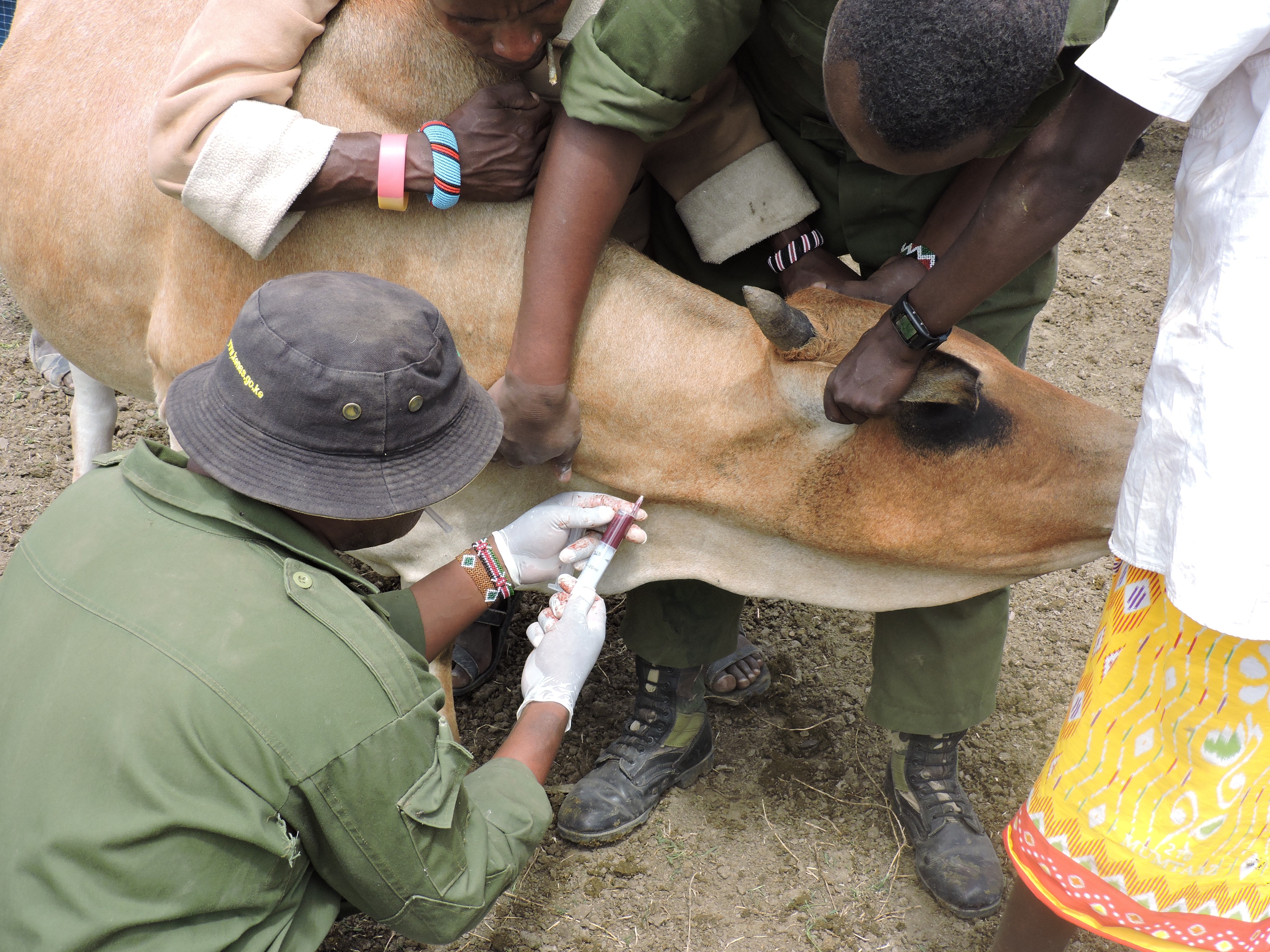|
Cycle 4 (2015 Deadline)
Enhancing conservation of African buffalo and rangeland habitat through molecular investigations of Foot-and-mouth disease at the wildlife-livestock interface
PI: Francis Gakuya (gakuya@kws.go.ke), Kenya Wildlife Service
U.S. Partner: Andres Perez, University of Minnesota
Project Dates: October 2015 - May 2018
Project Overview
Disease transmission at the wildlife-livestock interface is among the foremost challenges in wildlife conservation in landscapes shared by livestock and wildlife. Foot-and-mouth disease (FMD) is one of the most important animal diseases globally, and the virus has major impacts on a country’s ability to engage with the global livestock industry. One of the greatest challenges for FMD control in Africa is transmission of the virus between cattle and the primary wildlife reservoir, African buffalo (Syncerus caffer).
 | | Photo courtesy of Dr. Gakuya |
Nearly 70% of buffalo in east Africa are infected with FMD. Measures taken to separate cattle from wildlife to prevent transmission, such as the use of fences, have negative impacts on wildlife populations via habitat fragmentation and restriction of movement. This project will utilize molecular genetic techniques to address critical knowledge gaps about FMD transmission at the wildlife-livestock interface in Kenya, including quantifying transmission dynamics across multiple land-use scenarios and genetic characterization of circulating strains in each host to inform vaccine development. Specifically, the project objectives are to (1) characterize the frequency and directionality of transmission between buffalo and cattle, (2) determine the geographic sub-structuring of FMD virus across three localities of central Kenya, and (3) assess the effect of management strategies separating buffalo and cattle on FMD transmission dynamics.
Economic growth for the rural poor can be accelerated by removing constraints to livestock production and diversifying income growth through wildlife conservation. Specifically, access to lucrative beef markets for pastoral communities can be expanded by vertical integration programs, where commercial ranches partner with pastoralists to sell beef to high-value commercial markets. However, success of these programs is hampered by FMD outbreaks, which lead to severe trade restrictions. Results from this project will aid the development of strategies to control FMD. Moreover, the continued failure of the current polyvalent vaccine used in Kenya necessitates urgent study of the epidemiology and diversity of FMD virus strains circulating in domestic and wildlife populations.
More effective vaccines are crucial for FMD control strategies in order to minimize FMD outbreaks in livestock and, consequently, disease-driven human-wildlife conflict. Specifically, vaccines that are well matched to the genetic variants of the virus circulating in buffalo will reduce livestock morbidity and bridge the gap between livestock stakeholders and conservation goals. Results from this project will inform ongoing discussion on the merits of compartmentalization strategies and Disease-Free Zones for FMD control, as proposed in Kenya’s national development plan, Vision2030. Specifically, the project team will provide data on the land-use and management contexts in which buffalo are a source of FMD infection to cattle, and to what extent FMD in cattle living in the proposed Disease-Free Zone originates in buffalo as compared to other cattle populations. This information will help determine whether fencing wildlife is a viable option for FMD control, given its negative effects on conservation of wildlife habitat. Thus, addressing disease transmission at the wildlife-livestock interface is crucial for working with local stakeholders in rangelands used for both cattle production and conservation.
Summary of Activities
African buffalo are reservoirs for foot-and-mouth disease virus (FMDV), which is among the most important pathogens affecting livestock globally. The role of buffalo in the epidemiology of FMDV is poorly understood in eastern Africa, a region where cattle and wildlife populations regularly intermix.
In his PEER project, Dr. Gakuya used molecular genetic methods to evaluate the frequency of buffalo-cattle FMDV transmission in central Kenya and assess the phylogenetic relationship between FMDV outbreaks in cattle populations and viruses found in buffalo. They collected samples from 92 buffalo and 98 cattle from in and around Ol Pejeta Conservancy (OPC) in Laikipia County. Blood samples were analyzed for detection of antibodies to FMDV non-structural proteins, and oropharyngeal (probang) samples were used for virus isolation and genetic sequencing of the VP1 region (Sanger sequencing / Next-generation sequencing-NGS). In addition, 21 samples from cattle outbreaks were analyzed.
They recovered 75 sequences from buffalo, all of which were FMDV serotypes SAT1 or SAT1. NGS revealed dual infection by both serotypes in six buffalo, which is among the first demonstrations using sequencing of dual infection by multiple serotypes of a naturally infected host. Despite extensive contact with infected buffalo populations, no SAT1 or SAT2 viruses were found in cattle in OPC, suggesting that cross-species transmission is rare. An FMDV outbreak in OPC cattle was associated with serotype A and serotype O was found in cattle probang samples. Phylogenetic trees suggest that both of these cases were likely related to the introduction of animals from regions where OPC commonly purchases animals. At a broader spatial scale, SAT1 and SAT2 viruses found in buffalo showed close phylogenetic relationships with sequences associated with several outbreaks of FMDV in cattle elsewhere in central Kenya, suggesting that viral populations found in buffalo and cattle are intermixed. These results are preliminary and further analytical tools will be applied to assess the directionality of transmission between the two species.
In addition, viruses found in buffalo and in some cattle outbreaks were genetically distinct from current vaccine strains, suggesting that the vaccine utilized in Kenya may need to be reformulated to better protect cattle from circulating FMDV strains. These results will potentially change the current policy discussions in four main areas; enforcement of quarantine and movement restrictions in view of pastoralists lifestyle, veterinary vaccine development and assessing efficacy, integration of wildlife-livestock as a means to increase per acreage earning from the rangelands, and disease monitoring and management at the wildlife livestock interface.  | | Drawing blood for FMD virus testing. Photo courtesy of Dr. Gakuya |
Based on their results, the current FMDv vaccine may not be effective in preventing the disease in livestock and needs to be updated to control the disease. This is because the circulating virus (based on analyses sequences from their project - currently the largest analyzed buffalo sequences from a single population), are far removed from the current vaccine composite sequences.
It has also been revealed that the FMD viruses found in buffalo and cattle do appear to be intermixed, which provides the clearest evidence of linkages between FMDV in cattle and buffalo in Eastern Africa to-date. Further, our results also suggest that there is significant long-distance movement of FMDV across central Kenya, most likely related to livestock movements. This is shown by the close relation between viruses found in OPC cattle and viruses found in Isiolo and Nakuru, both of which are regions from which OPC purchases cattle.
Based on this results and the fact that fencing does appear to prevent disease transmission to buffalo, the project partners intend to engage in a broader policy discussion with the Director of Veterinary Services - Kenya, Foot-and-Mouth Disease Laboratory, Kenya Veterinary Vaccine Production Institute, and the Kenya Wildlife Service. This is already underway through sharing the results with the Foot and- Mouth Disease Laboratory and incorporation into the Directors brief. This will be followed up through a workshop discussion to generate policy recommendations. This is focused on four key areas; enforcement of quarantine and movement restrictions in view of pastoralists lifestyle, veterinary vaccine development and assessing efficacy, integration of wildlife-livestock as a means to increase per acreage earning from the rangelands, and disease monitoring and management at the wildlife-livestock interface.
The project partners have planned a follow-up study to be conducted in Masai Mara National Reserve and surrounding community conservancies (an area that has variable livestock-wildlife interaction and concomitant disease outbreaks). This sampling will partly be based on research grants submitted and through doctoral dissertation work by a PhD student in this grant (Dr. George O Paul). This will focus on Foot and- Mouth disease, Lumpy Skin Disease, Peste De Petits Ruminants (PPR) and Bovine tuberculosis.
The work will also cover other wild ungulates, including small herbivores such as antelopes, with a view to expanding the understanding of the epidemiological role of other species besides buffalo, and animal movement in the region. Future work will address other knowledge gaps about wildlife-livestock disease transmission in Kenya, including the roles of other species (antelopes, goats, and sheep) and the ecology of animal movement and cross species interactions.
|





